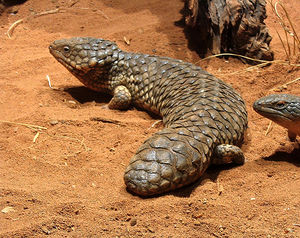Stump-tailed Skink
| This article has been peer reviewed but is awaiting expert review. If you would like to help with this, please see more information about expert reviewing. |
Scientific name: Tiliqua rugosus
Other names: Shingleback or Pinecone skink
Description
This lizard is in the same subfamily as the blue-tongued skink. They can grow to 25cm. They have very rough scales and look very much like a pinecone, hence one of the common names. They have a short fat stumpy tail, which acts as a food reserve. The lizard has a two heads appearance, which is an effective defence mechanism.
Range
These lizards are found in southern and south-eastern Australia. They live in the dry desert regions.
Enclosure
A medium-sized vivarium is suitable for these lizards; approximately 150 x 70 x 50cm will be large enough for a trio.
Lighting plays a very important part in the maintenance of lizards when kept in the vivarium. The correct lighting cycle (diurnal and nocturnal) provides the photoperiod, which helps to stimulate their feeding and breeding habits. Using a suitable tube can provide ultraviolet light.
Diet
These lizards have a fairly wide-ranged diet so are easy to provide for. They will eat one or a combination of the following foods: - insects, snails, pink mice, lean chopped pieces of beef, raw eggs, fruit, dog and cat food. A good quality vitamin supplement should be given with the food. A small water bowl should be provided.
Temperature
The vivarium should be heated to a daytime temperature of 22 to 35ºC and at night 16 to 22ºC.
Breeding
These viviparous lizards are bred in captivity. A single female produces 2 to 3 young a year. These are very heavy in body and are approximately 14cm in length.
Literature Search
Use these links to find recent scientific publications via CAB Abstracts (log in required unless accessing from a subscribing organisation).
Stump-tailed Skink (Tiliqua rugosus) publications

